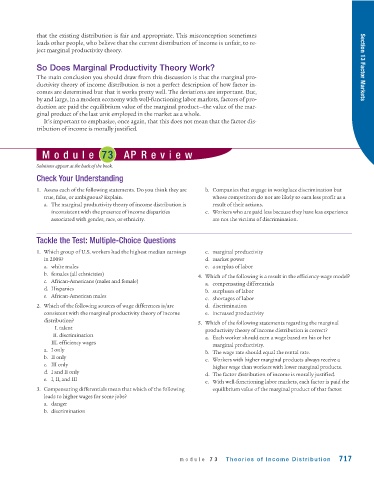Page 759 - Krugmans Economics for AP Text Book_Neat
P. 759
that the existing distribution is fair and appropriate. This misconception sometimes
leads other people, who believe that the current distribution of income is unfair, to re-
ject marginal productivity theory.
So Does Marginal Productivity Theory Work? Section 13 Factor Markets
The main conclusion you should draw from this discussion is that the marginal pro-
ductivity theory of income distribution is not a perfect description of how factor in-
comes are determined but that it works pretty well. The deviations are important. But,
by and large, in a modern economy with well-functioning labor markets, factors of pro-
duction are paid the equilibrium value of the marginal product—the value of the mar-
ginal product of the last unit employed in the market as a whole.
It’s important to emphasize, once again, that this does not mean that the factor dis-
tribution of income is morally justified.
Module 73 AP Review
Solutions appear at the back of the book.
Check Your Understanding
1. Assess each of the following statements. Do you think they are b. Companies that engage in workplace discrimination but
true, false, or ambiguous? Explain. whose competitors do not are likely to earn less profit as a
a. The marginal productivity theory of income distribution is result of their actions.
inconsistent with the presence of income disparities c. Workers who are paid less because they have less experience
associated with gender, race, or ethnicity. are not the victims of discrimination.
Tackle the Test: Multiple-Choice Questions
1. Which group of U.S. workers had the highest median earnings c. marginal productivity
in 2009? d. market power
a. white males e. a surplus of labor
b. females (all ethnicities)
4. Which of the following is a result in the efficiency-wage model?
c. African-Americans (males and female)
a. compensating differentials
d. Hispanics
b. surpluses of labor
e. African-American males
c. shortages of labor
2. Which of the following sources of wage differences is/are d. discrimination
consistent with the marginal productivity theory of income e. increased productivity
distribution?
5. Which of the following statements regarding the marginal
I. talent
productivity theory of income distribution is correct?
II. discrimination
a. Each worker should earn a wage based on his or her
III. efficiency wages
marginal productivity.
a. I only
b. The wage rate should equal the rental rate.
b. II only
c. Workers with higher marginal products always receive a
c. III only
higher wage than workers with lower marginal products.
d. I and II only
d. The factor distribution of income is morally justified.
e. I, II, and III
e. With well-functioning labor markets, each factor is paid the
3. Compensating differentials mean that which of the following equilibrium value of the marginal product of that factor.
leads to higher wages for some jobs?
a. danger
b. discrimination
module 73 Theories of Income Distribution 717

